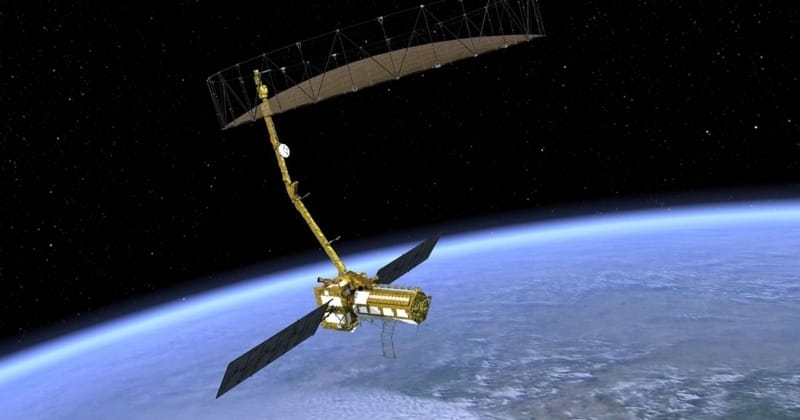NISAR Satellite Can Monitor Earth’s Tectonic Movements

- 15 May 2024
Why is it in the News?
ISRO Chairman S. Somanath recently announced that the NISAR satellite has the capability to accurately monitor tectonic movements and complete full mappings of the Earth twice a month.
About the NISAR Satellite:
- NISAR is a joint Earth-observing mission between NASA and the Indian Space Research Organization (ISRO).
- It is a Synthetic Aperture Radar satellite with two bands.
- It will be launched into a polar Sun-synchronous dawn-dusk orbit.
- One is the S-band and the other is the L-band.
- The S-band payload has been made by the ISRO and the L-band payload by the U.S.
- The U.S. will contribute to the large deployable antenna.
- This being a dual-band polarizable radar, it can do a lot of things.
- First, because it has a large deployable antenna with an 18-metre diameter, it has a very high swath.
- It can fully cover the earth in approximately 14 to 15 days, according to radar.
- It can monitor various aspects in very high resolution.
- For example, it can monitor the tectonic movements to centimetre accuracy.
- It can do measurements of water bodies accurately.
- It can look at water stressing on the earth, wherever there is a deficiency of water.
- It can ground-penetrate to a certain depth.
- It is capable of monitoring the vegetation cover and snow cover.
- It, therefore, basically looks at the whole of the earth in terms of surface, water, greenery and all of that.
- It measures accurately and gives repetitive, full coverage of the earth two times a month.
- It means it is capable of a lot of observation and this data will be available to both India and the U.S.
- We can study the water-stressing, climate change-related issues, and agricultural changes through patterns, yield, desertification and continental movements precisely with respect to annual water cycle movements.
- It can measure tectonic plate movements accurately.
- So a lot of geological, agricultural and water-related observations can be obtained from this satellite.
Mission Objectives:
- The primary goal of NISAR is to provide precise measurements of tectonic plate movements, enabling comprehensive observations in geology, agriculture, and water-related domains.
- Additionally, it aims to analyze water stress, climate change impacts, agricultural shifts, desertification, and continental shifts with accuracy, particularly concerning annual water cycle variations.
- NISAR's data will facilitate global resource and hazard management, while also aiding scientists in comprehending climate change dynamics and its effects.
Launch Schedule:
- Initially planned for July, the launch is now expected in October-November due to issues on the U.S. side requiring corrections.
Protection of Children from Sexual Offences (POCSO) Act

- 29 Mar 2024
Why is it in the News?
The Kerala High Court has held that a child charged with offenses under the Protection of Children from Sexual Offences (POCSO) Act, 2012, is to be prosecuted as per the provisions of the Juvenile Justice (Care and Protection of Children) (JJ) Act.
About the Protection of Children from Sexual Offences Act (POCSO Act):
- Enacted in 2012, the POCSO Act stands as India's pioneering legislation dedicated to addressing child sexual abuse comprehensively.
- Under the administration of the Ministry of Women and Child Development (MoWCD), its primary objective is safeguarding children under 18 from sexual assault, harassment, and exploitation, alongside establishing Special Courts to adjudicate such cases swiftly and efficiently, ensuring justice and protection for victims.
Salient Features of the Act:
- The POCSO Act adopts a gender-neutral approach, defining a child as "any person" under 18, ensuring inclusivity for all victims of child sexual abuse.
- It delineates various forms of sexual abuse, encompassing penetrative and non-penetrative assault, sexual harassment, and pornography.
- Certain circumstances, such as mental illness or abuse by a trusted individual like a family member, escalate the severity of sexual assault as per the Act.
- Individuals involved in trafficking children for sexual exploitation are subject to punishment under the Act's provisions on abetment.
- Attempting to commit an offense under the Act incurs penalties up to half the prescribed punishment for the completed offense.
- There's no time limit for reporting abuse, empowering victims to come forward at any point, regardless of when the abuse occurred.
- The Act mandates reporting of sexual abuse, penalizing failure to do so with imprisonment or fines.
- It includes child-friendly procedures for reporting, evidence recording, investigation, and trial, ensuring a supportive environment for victims.
- These procedures include recording the child's statement in a preferred location, preferably by a female officer, and avoiding aggressive questioning or character attacks.
- Medical examinations occur in the presence of a trusted individual, and the child is shielded from seeing the accused during testimony.
- Trials are held in camera, with the Special Court aiming to complete proceedings within a year of cognizance, prioritizing swift justice for victims.
Amendment to the Act:
- In 2019, the Act underwent its inaugural amendment to intensify penalties for particular offenses, aiming to dissuade perpetrators and safeguard the dignity of childhood.
- This amendment introduced the death penalty for aggravated penetrative sexual assault against children.
- Additionally, it empowered the imposition of fines and sentences of up to 20 years in prison to combat child pornography.
Australia’s Carbon Credits System

- 28 Mar 2024
Why is it in the News?
A recent study revealed that a prominent reforestation initiative operating within the Australian Carbon Credit Unit (ACCU) Scheme has been deemed a significant underperformer, amounting to a 'catastrophe' in terms of its outcomes.
What is the Australian Carbon Credit Unit (ACCU) Scheme?
- The ACCU Scheme plays a pivotal role in the Australian carbon market, incentivizing various entities including individuals, businesses, and governmental bodies to engage in endeavors aimed at mitigating emissions or sequestering carbon.
- Participants encompass a broad spectrum ranging from individuals and sole traders to corporations, local and state government entities, and trusts.
- Achievement of the scheme's objectives is facilitated through diverse means such as the adoption of innovative technologies, equipment upgrades, the adoption of sustainable business practices to enhance productivity or energy efficiency, and the implementation of novel vegetation management techniques.
How Does It Work?
- The ACCU Scheme operates by rewarding participants who execute projects focused on either reducing or avoiding greenhouse gas emissions (emissions avoidance) or capturing and storing atmospheric carbon (sequestration).
- These projects contribute significantly to mitigating climate change and advancing environmental sustainability in Australia.
- For each tonne of carbon dioxide equivalent (t CO?-e) emissions that a participant's project successfully stores or avoids, they are eligible to earn one Australian Carbon Credit Unit (ACCU).
- These ACCUs serve as a tangible representation of the project's positive environmental impact and can be traded on the secondary market or sold to the Australian Government through carbon abatement contracts.
- In essence, the ACCU Scheme establishes a robust framework for quantifying and monetizing emission reduction and carbon sequestration efforts, providing a strong financial incentive for individuals and businesses to actively engage in climate-friendly initiatives.
- By fostering an active carbon market, the scheme helps ensure the continued growth and development of innovative projects that combat climate change and support Australia's transition to a low-carbon economy.
Criticisms and Controversies:
- The ACCU Scheme has encountered criticisms and controversies regarding its overall effectiveness and the integrity of the carbon credits it generates.
- One such concern is based on research indicating that native forests in Australia's desert regions are experiencing either stagnant growth or shrinking woodlands.
- This finding raises questions about the capacity of these areas to sequester carbon at the levels claimed in ACCU projects.
- Furthermore, critics argue that Australia has amassed substantial quantities of carbon credits through these projects, despite the questionable integrity of the underlying data.
- The scheme's reliability and effectiveness are, thus, scrutinized, as the quality and accuracy of the carbon credits generated are essential to maintaining trust and credibility in the carbon market.
- As the ACCU Scheme evolves, addressing these concerns and ensuring that it genuinely contributes to emission reduction and carbon sequestration efforts is crucial.
- Regular evaluations and transparency in data collection and analysis will help enhance public confidence and secure the scheme's role as a central pillar of Australia's climate change mitigation strategy.
